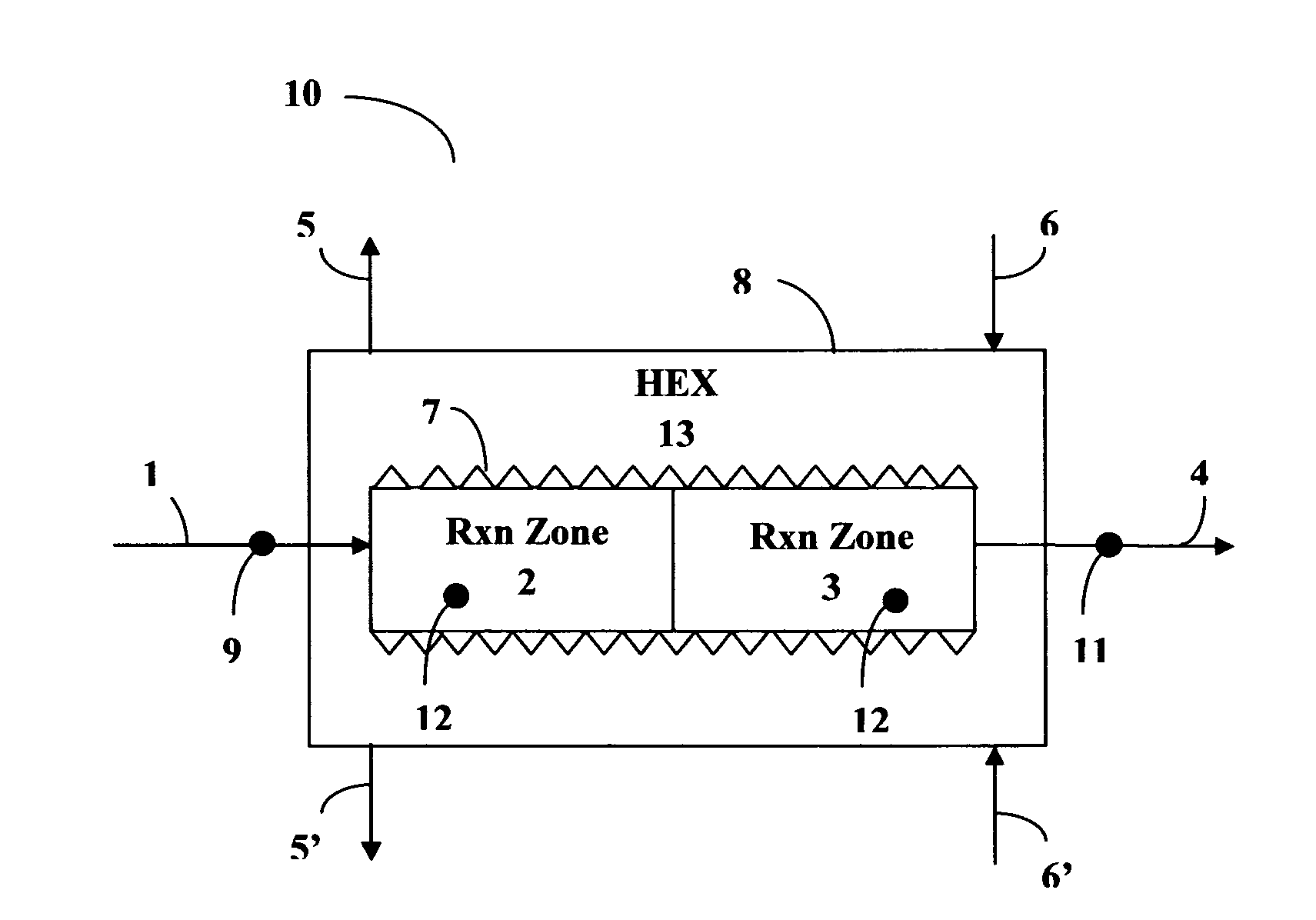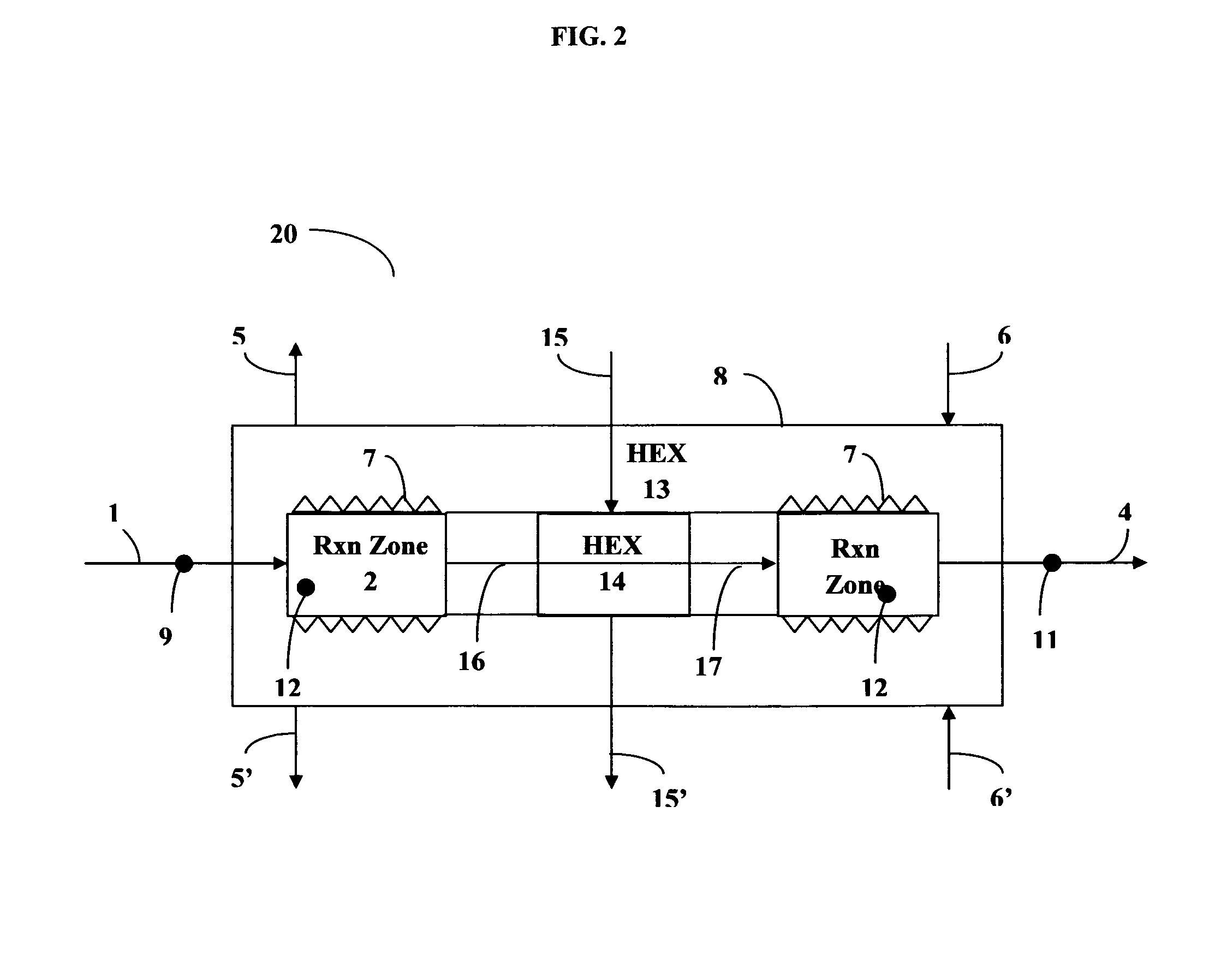Sabatier process and apparatus for controlling exothermic reaction
a technology of exothermic reaction and apparatus, which is applied in the preparation of oxygen-containing compounds, organic chemistry, hydrocarbon preparation catalysts, etc., can solve problems such as catalyst degradation, and achieve the effects of improving mechanical durability, reducing launch costs, and small launch payloads
- Summary
- Abstract
- Description
- Claims
- Application Information
AI Technical Summary
Benefits of technology
Problems solved by technology
Method used
Image
Examples
example 1
[0071]With reference to FIG. 1, a reactor 10 was constructed from stainless steel for use in the Sabatier process. The apparatus comprised two concentric tubes. A tube of larger diameter formed housing 8; an inner tube of smaller diameter provided a reactor section of two sequentially connected reaction zones 2 and 3. An annular space between the inner tube reactor section (2, 3) and the outer tubular housing 8 provided heat exchange section 13. A first inlet 1 was provided for feeding a mixture of carbon dioxide and hydrogen into the first reaction zone 2 comprising a first catalyst bed consisting of 15 layers of ultra-short-channel-length metal mesh substrate stacked one layer against the next layer. A second reaction zone 3 was positioned sequentially downstream of the first reaction zone 2. The second reaction zone 3 comprised 165 layers of ultra-short-channel-length metal mesh substrate, also stacked one layer against the next layer. The ultra-short-channel-length metal mesh su...
example 2
[0078]The process of Example 1 was repeated, with the exception that the inlet H2 / CO2 mole ratio was increased to 4.0 / 1. Results are tabulated in Table 3 and graphed in FIG. 4.
TABLE 3Sabatier Process Using Rh-Microlith ® brandultra-short-channel-length substrate and H2 / CO2 = 4.0 / 1SpaceT (° C.)T (° C.)CO2CH4VelocityCatalystCatalystAverageConversionSelectivity(hr−1)Bed 2Bed 3T (° C.)(mole %)(mole %)30,000216.0226.0221.092.1100.0257.5238.0247.892.9100.0521.5205.0363.393.198.5536.5252.0394.393.3100.0560.5348.0454.388.1100.060,000286.0374.0330.079.589.2380.0348.0364.081.696.4414.5350.0382.381.596.5476.0337.0406.580.9100.0561.5324.0442.882.9100.0555.5347.0451.381.498.7
example 3
[0079]Example 1 was repeated, with the exception that the H2 / CO2 mole ratio was increased to 5.5 / 1, with the results shown in Table 4 and in FIG. 5.
TABLE 4Sabatier Process Using Rh-Microlith ® brandultra-short-channel-length substrate and H2 / CO2 = 5.5 / 1SpaceT (° C.)T (° C.)CO2CH4VelocityCatalystCatalystAverageConversionSelectivity(hr−1)Bed 2Bed 3T (° C.)(mole %)(mole %)30,000242.5202.0222.399.8100.0347.8284.5316.199.3100.0520.5197.0358.899.6100.060,000287.5384.0335.888.2100.0378.5319.0348.890.8100.0469.3317.5393.490.9100.0
PUM
| Property | Measurement | Unit |
|---|---|---|
| pressure | aaaaa | aaaaa |
| channel lengths | aaaaa | aaaaa |
| temperature | aaaaa | aaaaa |
Abstract
Description
Claims
Application Information
 Login to View More
Login to View More - R&D
- Intellectual Property
- Life Sciences
- Materials
- Tech Scout
- Unparalleled Data Quality
- Higher Quality Content
- 60% Fewer Hallucinations
Browse by: Latest US Patents, China's latest patents, Technical Efficacy Thesaurus, Application Domain, Technology Topic, Popular Technical Reports.
© 2025 PatSnap. All rights reserved.Legal|Privacy policy|Modern Slavery Act Transparency Statement|Sitemap|About US| Contact US: help@patsnap.com



